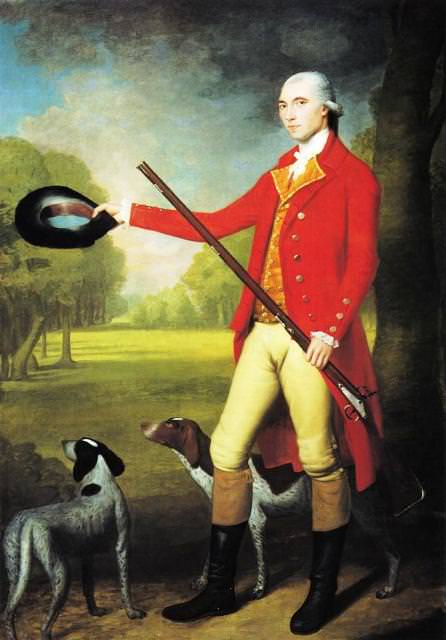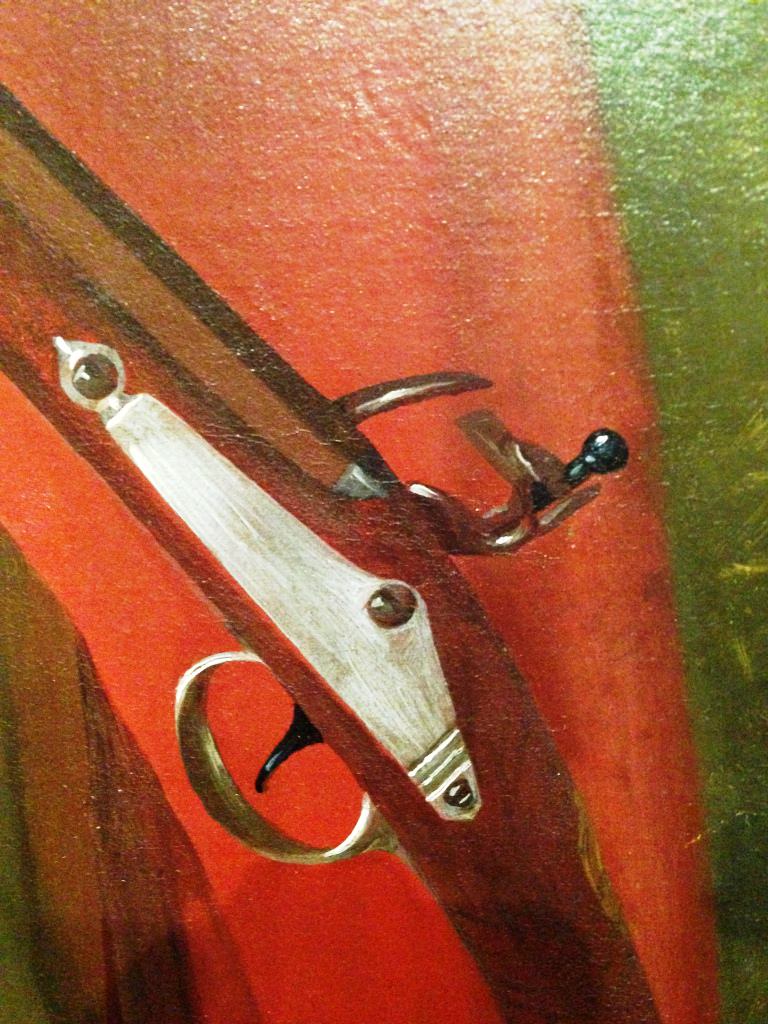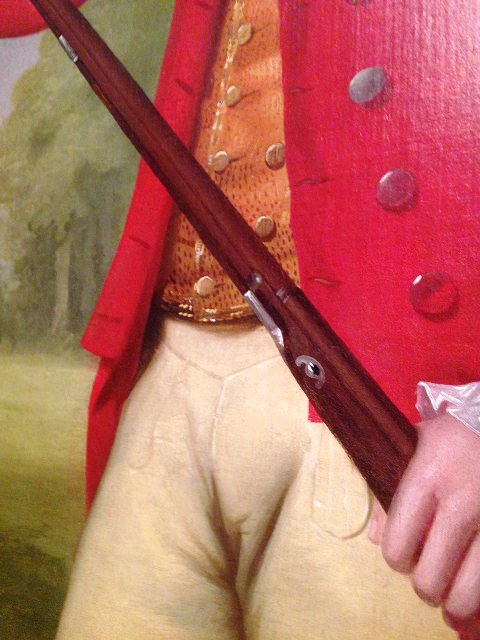I have read or think I have at least that a lot of original guns were left in the white. Did the buyer then brown or blue the gun or was it just left in the white or probably all three. If left in the white how did they protect the metal just by rubbing it with oil?
You are using an out of date browser. It may not display this or other websites correctly.
You should upgrade or use an alternative browser.
You should upgrade or use an alternative browser.
question on "In the white" metal
- Thread starter Bucky182
- Start date

Help Support Muzzleloading Forum:
This site may earn a commission from merchant affiliate
links, including eBay, Amazon, and others.
Military guns were often delivered “armory bright” and kept polished by soldiers using oil and brick dust on a rag.
- Joined
- Nov 26, 2005
- Messages
- 5,247
- Reaction score
- 11,028
Hi,
Until the last quarter of the 18th century, there were generally 3 ways barrels were treated. They were temper blued with heat, charcoal blued, or left bright but usually polished to some degree. There was a process called "russetting" that was used on some military guns during the 17th and early 18th centuries and some barrels on naval small arms were painted with some sort of asphaltum to blacken them. Russetting was probably similar to the asphaltum paint. It is not clear when rust browning was developed. John George in his book on English guns suggested it was known throughout the 18th century at least in Britain. However, it does not seem to have been very popular until the 1770s and later. In the painting below by Ralph Earl while in England during the late 1770s you can see the barrel of the English fowler was browned. Earl included many details including the silver side plate, standing breech on the barrel, and the half stock with rib. He clearly knew something about guns probably because he was related to Thomas Earl, a great 18th century New England gunsmith.




I suspect browning became popular then because twist and stub twist barrels were also becoming popular and acid browning really brought out the pattern in the barrel. By the early 19th century, English and probably European gunsmiths knew that if a rust browned barrel or part was boiled after rusting, the browning turned blue black. That treatment became popular as the 19th century progressed. On fine English guns from the end of the 18th century until mid-19th century, barrels were usually browned and other metal parts also browned or charcoal blued. Later, rust bluing tended to dominate.
In America, it is hard to believe that gun makers did not know about rust browning during the 18th century but there is no evidence of it on surviving long rifles and little evidence of the supplies to do it in surviving gun shop inventories. American makers did charcoal blue and temper blue barrels and parts during that time but most surviving rifles that are in almost pristine condition indicate the barrels were left bright as well as most iron or steel parts. Lock plates were often case hardened and on some guns, the colors from that process still show but casing was not to obtain colors as it is often used today. It was to put a hard skin on parts made of iron. Browning appears to start to become popular in America during the 19th century. One of the first guns with browned barrels and hardware of which I am aware was the model 1803 Harper's Ferry rifle. I think throughout the first half of the 19th century, barrels on American muzzleloading guns were likely browned or left bright. Iron and steel hardware was likely browned, case-colored, charcoal blued, or left bright.
dave
Until the last quarter of the 18th century, there were generally 3 ways barrels were treated. They were temper blued with heat, charcoal blued, or left bright but usually polished to some degree. There was a process called "russetting" that was used on some military guns during the 17th and early 18th centuries and some barrels on naval small arms were painted with some sort of asphaltum to blacken them. Russetting was probably similar to the asphaltum paint. It is not clear when rust browning was developed. John George in his book on English guns suggested it was known throughout the 18th century at least in Britain. However, it does not seem to have been very popular until the 1770s and later. In the painting below by Ralph Earl while in England during the late 1770s you can see the barrel of the English fowler was browned. Earl included many details including the silver side plate, standing breech on the barrel, and the half stock with rib. He clearly knew something about guns probably because he was related to Thomas Earl, a great 18th century New England gunsmith.




I suspect browning became popular then because twist and stub twist barrels were also becoming popular and acid browning really brought out the pattern in the barrel. By the early 19th century, English and probably European gunsmiths knew that if a rust browned barrel or part was boiled after rusting, the browning turned blue black. That treatment became popular as the 19th century progressed. On fine English guns from the end of the 18th century until mid-19th century, barrels were usually browned and other metal parts also browned or charcoal blued. Later, rust bluing tended to dominate.
In America, it is hard to believe that gun makers did not know about rust browning during the 18th century but there is no evidence of it on surviving long rifles and little evidence of the supplies to do it in surviving gun shop inventories. American makers did charcoal blue and temper blue barrels and parts during that time but most surviving rifles that are in almost pristine condition indicate the barrels were left bright as well as most iron or steel parts. Lock plates were often case hardened and on some guns, the colors from that process still show but casing was not to obtain colors as it is often used today. It was to put a hard skin on parts made of iron. Browning appears to start to become popular in America during the 19th century. One of the first guns with browned barrels and hardware of which I am aware was the model 1803 Harper's Ferry rifle. I think throughout the first half of the 19th century, barrels on American muzzleloading guns were likely browned or left bright. Iron and steel hardware was likely browned, case-colored, charcoal blued, or left bright.
dave
Expanding on what Dave wrote.
Depending on the use..., if the Gentleman above has a rifle with a bright barrel, it's likely going to stay pretty well rust free. He has the time or his servant has the time to keep the parts well oiled and free from rust, and he probably isn't exposing his firearm to the elements for many many days on end (ok in theory). Now a market hunter or fellow on a longhunt..., I've removed rust from my barrel with oil and ashes from the fire, or water and ashes from the fire. Then oiled the barrel to prevent rust's return. The metal gets stained, and over a short period of time in the field, the barrel would be considerably darker and blotchy because the means to keep a proper polish on the barrel simply are not at hand. Now a soldier, well you need something to keep the lads busy or they will get into mischief, so they get a polishing compound like brick dust (from 18th century bricks) and lard to keep the rust away and to keep the stains off the metal too.
LD
Depending on the use..., if the Gentleman above has a rifle with a bright barrel, it's likely going to stay pretty well rust free. He has the time or his servant has the time to keep the parts well oiled and free from rust, and he probably isn't exposing his firearm to the elements for many many days on end (ok in theory). Now a market hunter or fellow on a longhunt..., I've removed rust from my barrel with oil and ashes from the fire, or water and ashes from the fire. Then oiled the barrel to prevent rust's return. The metal gets stained, and over a short period of time in the field, the barrel would be considerably darker and blotchy because the means to keep a proper polish on the barrel simply are not at hand. Now a soldier, well you need something to keep the lads busy or they will get into mischief, so they get a polishing compound like brick dust (from 18th century bricks) and lard to keep the rust away and to keep the stains off the metal too.
LD
Brokennock
Cannon
I was thinking along the same lines as Loyalist.
Our barrels are made of far different material. A soldier's gun at the time was polished regularly to keep it bright, or, its original metal color. The average Joe gun owner, hunter, frontiersman, farmer, etc. who did not have someone to polish the barrel for him, may have received the gun with a bare metal barrel, but, what color was it after even just 6 months to a year of use? I would think it would darken much faster than our modern steel barrels.
Does anyone have access to a small sample of iron that would be close to period barrel material and a scrap of modern barrel? Could a test be arranged?
Our barrels are made of far different material. A soldier's gun at the time was polished regularly to keep it bright, or, its original metal color. The average Joe gun owner, hunter, frontiersman, farmer, etc. who did not have someone to polish the barrel for him, may have received the gun with a bare metal barrel, but, what color was it after even just 6 months to a year of use? I would think it would darken much faster than our modern steel barrels.
Does anyone have access to a small sample of iron that would be close to period barrel material and a scrap of modern barrel? Could a test be arranged?
Does anyone have access to a small sample of iron that would be close to period barrel material and a scrap of modern barrel? Could a test be arranged?
Use an original barrel.
Contact, IMA-USA and see if they have a damaged Brown Bess barrel they would part with cheap.
Not sure where to have it tested though.
- Joined
- Aug 15, 2010
- Messages
- 5,365
- Reaction score
- 5,122
Not an experiment as such, but some info to share. When I bought my Orion Barrel underhammer it had a nice brown, not very dark, but looking like it had been browned in its past. After I took it home I was talking to the seller and he told me it had never been blued, but sat in a cabinet in his shop for about 40 years. On the bottom flat you can see where someone head used a Magic Marker and wrote the twist and caliber. Otherwise, you'd think it was an amateur attempt to brown it.
My point is even if someone in the 1780's kept his barrel in the white, a few generations left in a closet etc would produce a brown barrel.
Just my thoughts.
My point is even if someone in the 1780's kept his barrel in the white, a few generations left in a closet etc would produce a brown barrel.
Just my thoughts.
My point is even if someone in the 1780's kept his barrel in the white, a few generations left in a closet etc would produce a brown barrel.
A grey barrel perhaps, but not brown I think.
Brokennock
Cannon
What year was that barrel made? Is it iron or steel?Not an experiment as such, but some info to share. When I bought my Orion Barrel underhammer it had a nice brown, not very dark, but looking like it had been browned in its past. After I took it home I was talking to the seller and he told me it had never been blued, but sat in a cabinet in his shop for about 40 years. On the bottom flat you can see where someone head used a Magic Marker and wrote the twist and caliber. Otherwise, you'd think it was an amateur attempt to brown it.
My point is even if someone in the 1780's kept his barrel in the white, a few generations left in a closet etc would produce a brown barrel.
Just my thoughts.
I'm wondering if iron would turn a different color than steel as it aged and tarnished. I'm also thinking iron would discolor faster.
As to using an original barrel, I'm not sure that using a 240 to 250+ year old barrel wouldn't skew the results.
I was wondering if anyone (the gunship at Colonial Williamsburg for example) is making iron barrels of an alloy close to what would have been used in the 18th century.
appalichian hunter
75 Cal.
- Joined
- Oct 28, 2018
- Messages
- 5,828
- Reaction score
- 9,477
Perhaps along the mentioned statements as to care with different factions such as military or civilian usage, the type of lubricants used say whale or bear oil or lard or even beef, mutton, groundhog what ever tallow would effect the coloring over long term usage or storage. As I no factual data to back the types of lubricants it would seem to me the population would use what lubricant was available at the time.
I’ve got original barrels made of iron. They do not oxidize substantially differently from modern mild steel barrels.
Brokennock
Cannon
Thank you Mr. PierceI’ve got original barrels made of iron. They do not oxidize substantially differently from modern mild steel barrels.
- Joined
- Jan 31, 2009
- Messages
- 13,235
- Reaction score
- 7,583
Who would want a bright shiny eye catcher for any functions other than marching in a straight line?
Mine are begging for brown. Haven't figured out how to approach browning the folding rear sight on a 1847 Springfield.
Mine are begging for brown. Haven't figured out how to approach browning the folding rear sight on a 1847 Springfield.
Who would want a bright shiny eye catcher for any functions other than marching in a straight line?
An "in the white" barrel doesn't have to be all bright and shiny.
- Joined
- Aug 15, 2010
- Messages
- 5,365
- Reaction score
- 5,122
A grey barrel perhaps, but not brown I think.
I'll post some pics of the untouched steel barrel, i think you'll be surprised it hasn't been browned.
Edit... was re-reading my first post and i see i accidentally used the word "blued" instead of "browned". Im sorry for my thick fingers.
Similar threads
- Replies
- 20
- Views
- 1K
- Replies
- 26
- Views
- 3K



